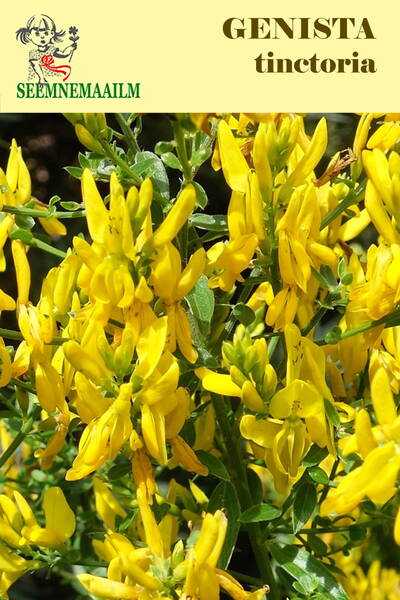A winter-hardy and unpretentious, fast-growing and very colorful shrub during the flowering period.
Perennial from the Papilionaceae family.
Height of flowering shrub: 85-100 cm.
Inflorescence colour: yellow.
Natural flowering period: June - September (duration of flowering 40-65 days).
Soil requirements: average.
Winter hardiness zones: Z3 - Z8.
1.0 g = 235 seeds.
Fruit - narrow-oblong, laterally compressed bean.
Light-loving, drought-resistant and quite winter-hardy in Estonia (in cold, snowless winters it freezes significantly, but quickly recovers and blooms). Prefers dry, sandy, infertile, limed soils, although it can withstand prolonged flooding. Flowering worsens on fertile soils.
Genista tinctoria is propagated by seeds and cuttings, which take root with difficulty without the use of stimulants. Seedlings begin to bear fruit at the age of two. If seeds are not required, the stems on which the flowers were are cut after flowering to stimulate abundant flowering the following year.
Dyer's broom is used in landscaping in the form of small groups, it looks especially good on slopes, rocky areas, in rock gardens and borders, as well as near small trees or tall bushes that bloom simultaneously or alternately and combine beautifully with each other not only in flowering, but also in the shape and color of the leaves.
* Previously, a stable yellow dye for linen and silk fabrics was obtained from the shoots, leaves and flowers of broom, and the flexible stems of the bush were used for weaving.
Eng.: Dyer's greenweed, base-broom, dyer's broom, dyer's greenwood, dyer's weed, greenweed, waxen woad, wede-wixen, woodwaxen, woud-wix. Bot. syn.: Genista depressa M.B.,Bot. syn.: Genista alpestris Bertol., Genista anxantica Ten., Genista borysthenica Kotov, Genista campestris Janka.
The herb Genista tinctoria is used for medicinal purposes.
The herb contains alkaloids, glycosides, organic acids, essential oil, scoparine, triterpene saponins, bitter substances, wax, and mucus.
Preparations from the herb Genista tinctoria have a choleretic, diuretic, laxative, analgesic, hemostatic, and metabolic-improving effect.
In folk medicine, an infusion of the herb is used for liver diseases, urinary tract stones, jaundice, dropsy, as a diuretic and laxative, as well as for various skin diseases (lichen, boils, allergic dermatitis). Externally, a decoction and infusion are used to treat boils, lichen, and diathesis. For these purposes, a decoction is prepared (4 tablespoons per 1 liter of water), which is filtered and poured into a full bath.
! The plant (especially the seeds) is poisonous and should only be used as directed by a physician.












